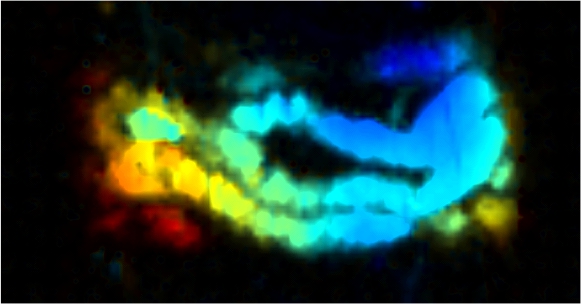Nanojuice: Getting a Real-Time View of GI Motility
Posted on by Dr. Francis Collins

Caption: A real-time image of nanojuice as it passes through a mouse’s small intestine. A laser causes particles in the nanojuice to vibrate, creating vibrations picked up by an ultrasound detector that are then used to generate a black-and-white image. Rainbow colors are added afterward to reflect the depth of the intestine within the mouse’s abdomen: blue is closest to the surface and red is deepest.
Credit: Jonathan Lovell, University at Buffalo
For those of you who love to try new juices, you’ve probably checked out acai, goji berry, and maybe even cold-pressed kale. But have you heard of nanojuice? While it’s not a new kind of health food, this scientific invention may someday help to improve human health through its power to visualize the action of the gastrointestinal (GI) tract in real-time.
It’s true that doctors already have many imaging tools at their disposal to examine various parts of the GI tract—all the way from throat to colon. These include invasive techniques, such as upper endoscopy and colonoscopy; as well as non-invasive approaches, such as ultrasound, magnetic resonance imaging, and X-ray procedures that may or may not involve swallowing a chalky liquid containing barium or other materials that are radio-opaque. There’s even a wireless capsule that can shoot videos as it travels all the way through the GI tract. None of these techniques, however, provides a non-invasive, real-time view of the wave-like muscle contractions that move food through the gut—a crucial process called peristalsis.
If we could find a way to image peristalsis easily and effectively in real time, it would aid in the diagnosis and treatment of the wide range of disorders that affect GI motility. Such disorders include bacterial infections, inflammatory bowel disease, and irritable bowel syndrome, as well as thyroid disorders, diabetes, effects of certain medicines, Parkinson’s disease, and other neurologic conditions.
In his search for better imaging methods, Jonathan Lovell, a bioengineer at the University at Buffalo and recipient of the NIH Director’s Early Independence Award, was attracted to the optical properties of a family of chemical dyes called naphthalocyanines. However, the dyes weren’t perfect: they didn’t dissolve in water and they also raised toxicity concerns because, like most small molecules, they pass through the lining of the gut and into the bloodstream. To overcome these issues, Lovell and his team encased the naphthalocyanines in carrier molecules made of FDA-approved polymers and dubbed the combo ‘nanonaps.’ When the nanonaps are suspended in water so they can be swallowed, you end up with a solution called nanojuice.
Lovell recently tested this nanojuice in tandem with a new technology, called photoacoustic tomography, that emits laser pulses that excite the nanonaps. Those pulses can penetrate up to 5 cm in tissue and are harmless. As the nanonaps respond, an ultrasound detector detects their vibrations, producing an image. In his experiments in which mice drank nanojuice after fasting for 12 hours, Lovell found that the nanonaps were safe and passed through the animals without any absorption into the bloodstream. He’s also proved that he can use his new method to detect blockages in the mouse GI tract, and, perhaps most importantly, to capture real-time images of peristalsis in the animals’ small intestine [1].
To date, Lovell has developed four ‘flavors’ of nanojuice, each of which responds to different wavelengths of laser light. He hopes to target the nanonaps in each of these juices to detect different diseases so that they can be used to screen the GI tract simultaneously for a variety of disorders. He expects pilot clinical trials in humans to begin within a few years.
Reference:
[1] Non-invasive multimodal functional imaging of the intestine with frozen micellar naphthalocyanines. Zhang Y, Jeon M, Rich LJ, Hong H, Geng J, Zhang Y, Shi S, Barnhart TE, Alexandridis P, Huizinga JD, Seshadri M, Cai W, Kim C, Lovell JF. Nat Nanotechnol. 2014 Jul 6.
Links:
NIH Director’s Early Independence Awards. (NIH Common Fund)
Lovell Lab, University at Buffalo, NY
NIH support: National Cancer Institute; Common Fund; Office of the Director

This is a great article …